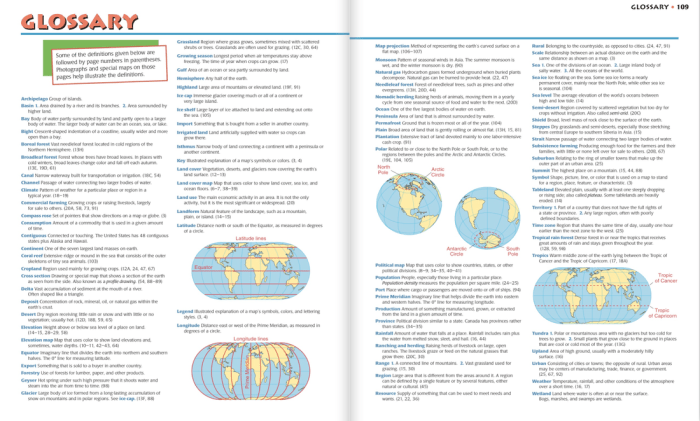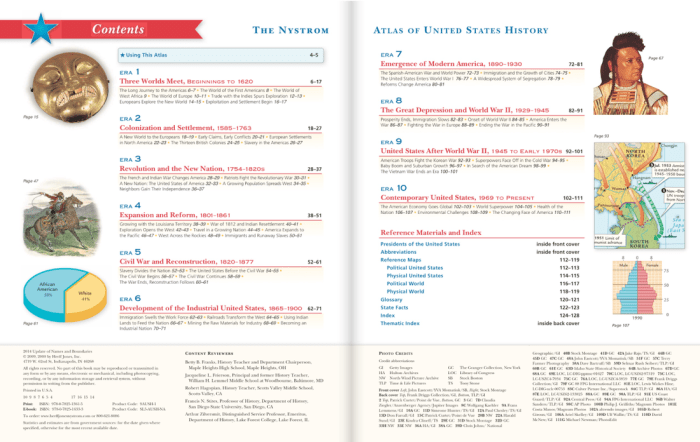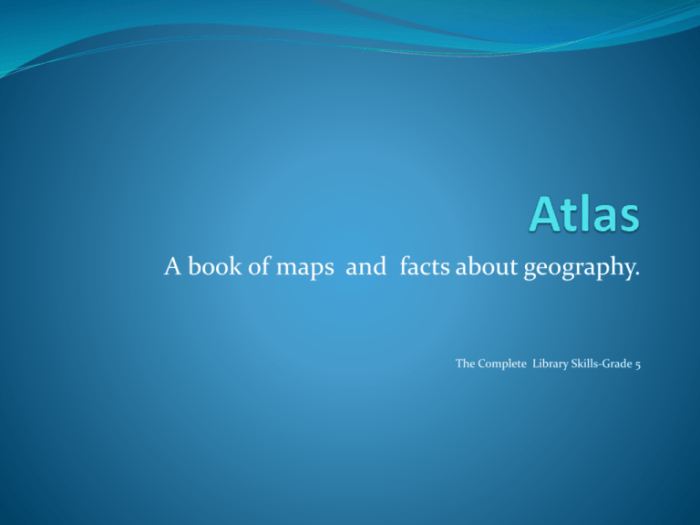Embark on a captivating journey into the realm of cartography with our comprehensive guide to “Getting to Know Your Atlas Answer Key.” This indispensable resource will illuminate the intricacies of atlases, empowering you to navigate the world of maps, charts, and tables with confidence and precision.
Delve into the history, components, and applications of atlases, unlocking their secrets and revealing their profound impact on our understanding of the world around us. Whether you’re a seasoned traveler, a curious student, or simply seeking to expand your knowledge, this guide will serve as your trusted companion.
Atlas Introduction

An atlas is a collection of maps that provide a comprehensive overview of a particular region, country, or the entire world. It is an indispensable tool for geographers, historians, and anyone interested in understanding the spatial distribution of various geographical features, political boundaries, and other relevant information.
Atlases serve several purposes, including:
- Providing a visual representation of the Earth’s surface and its features
- Depicting the distribution of natural resources, climate patterns, and other environmental factors
- Illustrating historical events and political changes over time
- Facilitating the planning and execution of travel routes and expeditions
Types of Atlases
Atlases can be classified into various types based on their scope, scale, and intended audience:
- World atlasesprovide a comprehensive overview of the entire world, including maps of continents, countries, and major cities.
- Regional atlasesfocus on a specific region or continent, providing more detailed maps and information about that particular area.
- National atlasesare designed to provide detailed information about a specific country, including its geography, history, economy, and culture.
- Thematic atlasesare designed to explore a specific theme or topic, such as climate, geology, or population distribution.
- Historical atlasesdepict historical events and political changes over time, providing valuable insights into the evolution of human societies and the development of civilizations.
History of Atlases
The concept of an atlas can be traced back to ancient times, with early examples found in the works of Greek geographers such as Ptolemy and Strabo. The term “atlas” itself is derived from the mythical Titan Atlas, who was depicted carrying the globe on his shoulders.
The first modern atlas was published in 1570 by the Flemish cartographer Abraham Ortelius. Ortelius’s atlas, titled “Theatrum Orbis Terrarum,” contained 53 maps and revolutionized the field of cartography by providing a standardized and comprehensive collection of maps in a single volume.
Since then, atlases have continued to evolve and improve, with the advent of new technologies and the increasing availability of geographic data. Today, atlases are an essential resource for a wide range of disciplines, including geography, history, political science, and environmental studies.
Components of an Atlas

An atlas is a collection of maps, charts, and tables that provide comprehensive information about a particular subject or region. These components work together to present a visual representation of data, making it easier to understand and analyze.
The key components of an atlas include:
Maps
Maps are the primary component of an atlas and provide a visual representation of a geographical area. They show the physical features, political boundaries, and other important landmarks of a region. Maps can be used for navigation, planning, and understanding the distribution of resources and populations.
Charts
Charts are graphical representations of data that show trends, patterns, and relationships. They can be used to compare different data sets, visualize changes over time, and identify correlations between variables. Charts are commonly used in atlases to present statistical information, such as population density, economic indicators, and climate data.
Tables
Tables are organized arrangements of data in rows and columns. They provide a concise and structured way to present information, such as lists of cities, statistics, or historical events. Tables can be used to compare data across different categories, identify trends, and make comparisons.
Together, these components provide a comprehensive understanding of a particular subject or region. Atlases are valuable resources for researchers, students, and anyone interested in gaining insights into the world around them.
Using an Atlas
An atlas is a collection of maps, charts, and tables that provide geographic information about the world or a specific region. To use an atlas effectively, it is important to understand the different types of information it contains and how to interpret it.
The first step in using an atlas is to identify the type of information you are looking for. Atlases typically contain physical maps, which show the natural features of an area, such as mountains, rivers, and forests; political maps, which show the boundaries of countries, states, and other political units; and thematic maps, which show specific data about an area, such as population density or climate.
Once you have identified the type of information you are looking for, you can use the index to find the appropriate map or chart. The index is typically located at the back of the atlas and lists the topics covered in the atlas.
Once you have found the appropriate map or chart, you can use the legend to interpret the symbols and colors used.
Interpreting Maps
Maps are a two-dimensional representation of a three-dimensional world. This means that some distortion is inevitable. The most common types of map projections are the Mercator projection, which is used for navigation, and the Robinson projection, which is used for general reference.
Each projection has its own advantages and disadvantages.
When interpreting a map, it is important to pay attention to the scale. The scale tells you how much distance on the map represents a certain distance on the ground. For example, a map with a scale of 1:24,000 means that one inch on the map represents 24,000 inches on the ground.
Another important aspect of interpreting maps is to understand the symbols and colors used. The legend will tell you what each symbol and color represents. For example, a blue line on a map may represent a river, while a green area may represent a forest.
Interpreting Charts and Tables
Charts and tables are used to present data in a clear and concise way. Charts can be used to show trends, comparisons, and other relationships between data. Tables can be used to present data in a more organized way.
When interpreting charts and tables, it is important to pay attention to the labels and units of measurement. The labels will tell you what the data is about, and the units of measurement will tell you how the data is being measured.
For example, a chart may show the population of a country over time. The labels will tell you that the chart is about population, and the units of measurement will tell you that the population is being measured in millions.
Common Pitfalls and Challenges
There are a few common pitfalls and challenges to be aware of when using an atlas. One pitfall is to rely too heavily on a single map or chart. It is important to use multiple sources of information to get a complete picture of an area.
Another pitfall is to assume that all maps are accurate. Maps are created by humans, and they can contain errors. It is important to be aware of the potential for errors when using maps.
Finally, it is important to remember that maps are a simplified representation of the world. They cannot show all of the detail that exists in the real world. It is important to be aware of the limitations of maps when using them.
Atlas Applications

Atlases are invaluable tools that serve a wide range of applications across various fields, including geography, history, travel, education, research, decision-making, and problem-solving.
In Geography
- Atlases provide detailed maps and geographical information, aiding in understanding the physical and political features of the Earth’s surface.
- They assist in comprehending the distribution of natural resources, landforms, climate patterns, and population density.
In History, Getting to know your atlas answer key
- Historical atlases offer maps and timelines that illustrate the evolution of civilizations, empires, and political boundaries over time.
- They enable researchers to visualize the geographical context of historical events and trace the movement of people and ideas.
In Travel
- Travel atlases provide essential information for planning trips, including maps, distances, and points of interest.
- They help travelers navigate unfamiliar areas, identify potential routes, and discover hidden gems.
In Education and Research
- Atlases serve as valuable resources for students and researchers, offering a comprehensive visual representation of geographical and historical data.
- They facilitate the analysis of spatial patterns, the identification of trends, and the development of research hypotheses.
In Decision-Making and Problem-Solving
- Atlases provide crucial information for decision-makers in various fields, such as urban planning, environmental management, and resource allocation.
- They enable the visualization of complex spatial data, allowing for informed decision-making and effective problem-solving.
Digital Atlases

Digital atlases are interactive, computer-based versions of traditional printed atlases. They offer several advantages over their printed counterparts, including:
- Convenience:Digital atlases can be accessed from anywhere with an internet connection, making them ideal for on-the-go use.
- Portability:Digital atlases are stored on electronic devices, eliminating the need to carry heavy printed atlases.
- Searchability:Digital atlases allow users to quickly and easily search for specific locations or information.
- Updatability:Digital atlases can be updated regularly, ensuring that users have access to the most current information.
In addition to these advantages, digital atlases also offer a number of features and capabilities that are not available in printed atlases, such as:
- Interactive maps:Digital atlases allow users to zoom in and out of maps, pan around, and view different layers of information.
- 3D maps:Some digital atlases offer 3D maps, which provide a more realistic view of the terrain.
- Routing and navigation:Digital atlases can be used for routing and navigation, providing turn-by-turn directions.
- Data analysis:Digital atlases can be used to analyze data, such as population density or land use.
Digital atlases are being used in a variety of contexts, including:
- Education:Digital atlases are used in schools and universities to teach geography and other subjects.
- Business:Digital atlases are used by businesses to analyze market data, plan logistics, and make other decisions.
- Government:Digital atlases are used by government agencies for planning, disaster response, and other purposes.
- Personal use:Digital atlases are used by individuals for travel planning, recreation, and other purposes.
FAQ Section: Getting To Know Your Atlas Answer Key
What is an atlas?
An atlas is a collection of maps, charts, and tables that provide geographic information about the world or a specific region.
What are the different types of atlases?
There are various types of atlases, including world atlases, regional atlases, historical atlases, and thematic atlases.
How do I use an atlas effectively?
To use an atlas effectively, identify the relevant map, chart, or table, and interpret the symbols, scales, and legends to extract the desired information.